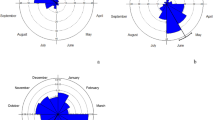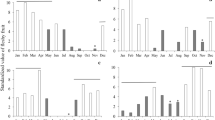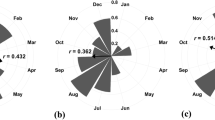Abstract
Seasonal breeding in primates is related to the degree of environmental seasonality, particularly the availability and predictability of food. Southeast Asian species in general show moderate birth seasonality due to either low environmental seasonality or unpredictable fluctuations of mast-fruiting food resources. One Southeast Asian primate, the simakobu (Simias concolor), however, has been reported to be a strict seasonal breeder with births occurring in June and July only. It is unclear whether these observations are characteristic of the species or result from a sampling bias. To address this question, we documented the annual distribution of 11 births in eight groups of simakobu over two consecutive years at Pungut, an undisturbed site on Siberut Island, Indonesia. We assessed annual variation in ecology and reproduction via rainfall, temperature, food availability, feeding time, physical condition, conceptions, and births. Mean monthly temperature was nearly constant (26.3–27.1 °C), and monthly precipitation always high (219–432 mm). Although simakobu foods were abundant year-round, there were two fruit-feeding peaks in June and September. In contrast to previous reports, we documented births in 7 mo. Most births occurred in October (45 %), the wettest month of the year, and most conceptions in March and April, following a peak in unripe fruit availability. Although sample sizes are very small, females seemed to conceive when their physical condition was best, suggesting that simakobu time conceptions flexibly to the recovery of energy reserves. Across study sites, births occurred in 10 calendar months, indicating that simakobu reproduction is not strictly seasonal.





Similar content being viewed by others
References
Ashton, P. S., Givnish, T. J., & Appanah, S. (1988). Staggered flowering in the dipterocarpaceae: new insights into floral induction and the evolution of mast fruiting in the aseasonal tropics. American Naturalist, 132, 44–66.
Batschelet, E. (1981). Circular statistics in biology. New York: Academic Press.
Borries, C., Lu, A., Ossi-Lupo, K., Larney, E., & Koenig, A. (2011). Primate life histories and dietary adaptations: a comparison of Asian colobines and macaques. American Journal of Physical Anthropology, 144, 286–299.
Brockman, D. K., & van Schaik, C. P. (2005). Seasonality and reproductive function. In D. K. Brockman & C. P. van Schaik (Eds.), Seasonality in primates: Studies of living and extinct human and non-human primates (pp. 269–305). Cambridge, UK: Cambridge University Press.
Di Bitetti, M. S., & Janson, C. H. (2000). When will the stork arrive? Patterns of birth seasonality in neotropical primates. American Journal of Primatology, 50, 109–130.
Drent, R. H., & Daan, S. (1980). The prudent parent: Energetic adjustments in avian breeding. In H. Klomp & J. W. Woldendrop (Eds.), The integrated study of bird populations (pp. 225–252). New York: North Holland.
Erb, W. M. (2008). Conservation small grant award report: Behavioral ecology of simakobu monkeys (Simias concolor) in northern Siberut, Indonesia. ASP Bulletin, 32, 8–10.
Erb, W. M., Borries, C., Lestari, N. S., & Ziegler, T. (2012). Demography of simakobu (Simias concolor) and the impact of human disturbance. American Journal of Primatology, 74, 580–590.
Ganzhorn, J. U., Klaus, S., Ortmann, S., & Schmid, J. (2003). Adaptations to seasonality: Some primate and nonprimate examples. In P. M. Kappeler & M. E. Pereira (Eds.), Primate life histories and socioecology (pp. 132–148). Chicago: The University of Chicago Press.
Gurmaya, K. J. (1986). Ecology and behavior of Presbytis thomasi in Northern Sumatra. Primates, 27, 151–172.
Hadi, S., Ziegler, T., & Hodges, J. K. (2009). Group structure and physical characteristics of simakobu monkeys (Simias concolor) on the Mentawai Island of Siberut, Indonesia. Folia Primatologica, 80, 74–82.
Hijmans, R. J., Cameron, S. E., Parra, J. L., Jones, P. G., & Jarvis, A. (2005). Very high resolution interpolated climate surfaces for global land areas. International Journal of Climatology, 25, 1965–1978.
Janson, C. H., & Verdolin, J. (2005). Seasonality of primate births in relation to climate. In D. K. Brockman & C. P. van Schaik (Eds.), Seasonality in primates: Studies of living and extinct human and non-human primates (pp. 307–349). Cambridge, UK: Cambridge University Press.
Jönsson, K. I. (1997). Capital and income breeding as alternative tactics of resource use in reproduction. Oikos, 78, 57–66.
Koenig, A., Borries, C., Chalise, M. K., & Winkler, P. (1997). Ecology, nutrition, and timing of reproductive events in an Asian primate, the Hanuman langur (Presbytis entellus). Journal of Zoology, 243, 215–235.
Lancaster, J. B., & Lee, R. B. (1965). The annual reproductive cycle in monkeys and apes. In I. DeVore (Ed.), Primate behavior: Field studies of monkeys and apes (pp. 486–513). New York: Holt, Rinehart and Winston.
Lee, P. C., Majluf, P., & Gordon, I. J. (1991). Growth, weaning and maternal investment from a comparative perspective. Journal of Zoology, 225, 99–114.
Lewis, R. J., & Kappeler, P. M. (2005). Seasonality, body condition, and timing of reproduction in Propithecus verreauxi verreauxi in the Kirindy Forest. American Journal of Primatology, 67, 347–364.
Lindburg, D. G. (1987). Seasonality of reproduction in primates. In E. J. Mitchell (Ed.), Comparative primate biology (Vol. 2B, pp. 167–218). New York: Alan R. Liss.
Marsh, C. W. (1981). Diet choice among red colobus (Colobus badius rufomitratus) on the Tana River, Kenya. Folia Primatologica, 35, 147–178.
Newton, P. N., & Dunbar, R. I. M. (1994). Colobine monkey society. In A. G. Davies & J. F. Oates (Eds.), Colobine monkeys: Their ecology, behaviour and evolution (pp. 311–346). Cambridge, UK: Cambridge University Press.
Paciulli, L. M. (2010). The relationship between nonhuman primate densities and vegetation on the Pagai, Mentawai Islands, Indonesia. In S. Gursky-Doyen & J. Supriatna (Eds.), Indonesian primates (pp. 199–215). New York: Springer.
Phiapalath, P., Borries, C., & Suwanwaree, P. (2011). Seasonality of group size, feeding, and breeding in wild red-shanked douc langurs (Lao PDR). American Journal of Primatology, 73, 1134–1144.
Ruhiyat, Y. (1983). Socio-ecological study of Presbytis aygula in West Java. Primates, 24, 344–359.
Smith, R. J., & Jungers, W. L. (1997). Body mass in comparative primatology. Journal of Human Evolution, 32, 523–559.
Stearns, S. C. (1989). Trade-offs in life-history evolution. Functional Ecology, 3, 259–268.
Stearns, S. C. (1992). The evolution of life histories. New York: Oxford University Press.
Tenaza, R. R., & Fuentes, A. (1995). Monandrous social organization of pigtailed langurs (Simias concolor) in the Pagai Islands, Indonesia. International Journal of Primatology, 16, 295–310.
Tilson, R. L. (1977). Social organization of simakobu monkeys (Nasalis concolor) in Siberut Island, Indonesia. Journal of Mammalogy, 58, 202–212.
van Noordwijk, M. A., & van Schaik, C. P. (1999). The effects of dominance rank and group size on female lifetime reproductive success in wild long-tailed macaques, Macaca fascicularis. Primates, 40, 105–130.
van Noordwijk, M. A., & van Schaik, C. P. (2004). Sexual selection and the careers of primate males: Paternity concentration, dominance-acquisition tactics and transfer decisions. In P. M. Kappeler & C. P. van Schaik (Eds.), Sexual selection in primates: New and comparative perspectives (pp. 208–229). Cambridge, UK: Cambridge University Press.
van Schaik, C. P., & van Noordwijk, M. A. (1985). Interannual variability in fruit abundance and the reproductive seasonality in Sumatran Long-tailed macaques (Macaca fascicularis). Journal of Zoology, 206, 533–549.
Walter, H. (1994). Vegetation of the earth and ecological systems of the geo-biosphere. Berlin: Springer.
Waltert, M., Abegg, C., Ziegler, T., Hadi, S., Priata, D., & Hodges, J. K. (2008). Abundance and community structure of Mentawai primates in the Peleonan Forest, North Siberut, Indonesia. Oryx, 42, 375–379.
Watanabe, K. (1981). Variations in group composition and population density of the two sympatric Mentawaian leaf-monkeys. Primates, 22, 145–160.
Watts, D. P. (1998). Seasonality in the ecology and life histories of mountain gorillas (Gorilla gorilla beringei). International Journal of Primatology, 19, 929–948.
Whittaker, D. J. (2005). New population estimates for the endemic Kloss’s gibbon Hylobates klossii on the Mentawai Islands, Indonesia. Oryx, 39, 458–461.
Whitten, A. J. (1980). The Kloss gibbon in Siberut rain forest. Ph.D. thesis, King’s College, Cambridge.
Whitten, A. J. (1982a). The gibbons of Siberut. London: J. M. Dent & Sons.
Whitten, A. J. (1982b). A numerical analysis of tropical rain forest, using floristic and structural data, and its application to an analysis of gibbon ranging behaviour. Journal of Ecology, 70, 249–271.
Wolf, K. E. (1984). Reproductive competition among co-resident male silvered leaf monkeys (Presbytis cristata). Ph.D. thesis, Yale University.
Acknowledgments
W. M. Erb gratefully acknowledges contributions from members of her dissertation committee —Julia Fischer, Charles Janson, Ryne Palombit, and Patricia Wright— as well as field assistants Edith Sabara, Ira Sari, Rima Agustina, Hermanto Salamanang, Lucien Salamanang, and Karta Salamanang. We thank Jan Gogarten for help with statistics and the editor-in-chief Joanna Setchell and two anonymous reviewers for their very helpful comments on the manuscript. This work was supported by the American Society of Primatologists; the Margot Marsh Biodiversity Fund; the National Science Foundation (BCS-0752504); the Primate Action Fund; Primate Conservation, Inc.; and Stony Brook University. We are grateful to the Indonesian Institute of Sciences and the Indonesian State Ministry for Research and Technology for granting permission to undertake this research.
Author information
Authors and Affiliations
Corresponding author
Rights and permissions
About this article
Cite this article
Erb, W.M., Borries, C., Lestari, N.S. et al. Annual Variation in Ecology and Reproduction of Wild Simakobu (Simias concolor). Int J Primatol 33, 1406–1419 (2012). https://doi.org/10.1007/s10764-012-9630-3
Received:
Accepted:
Published:
Issue Date:
DOI: https://doi.org/10.1007/s10764-012-9630-3




